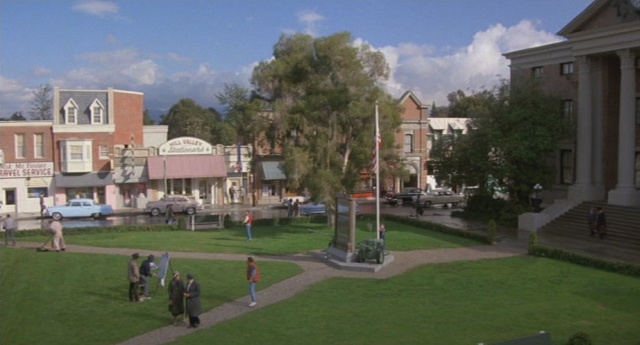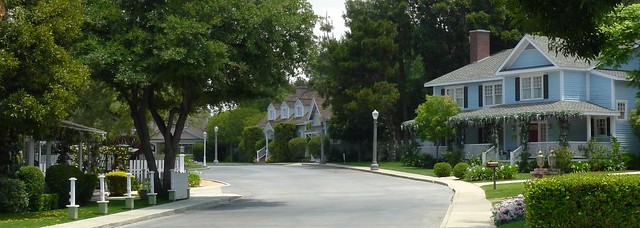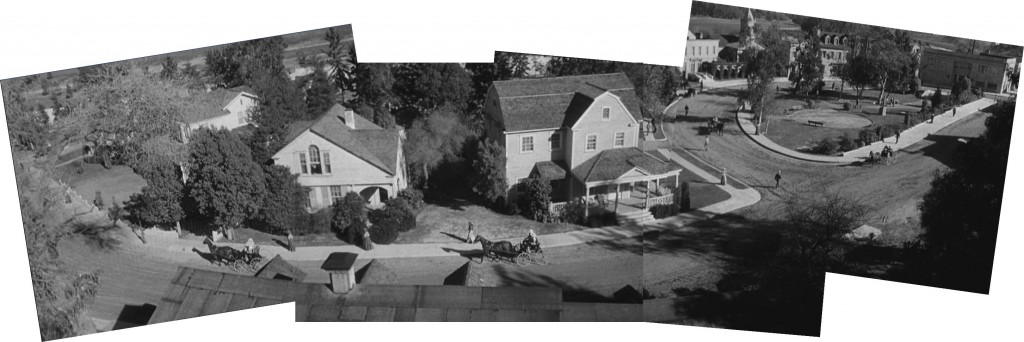
I am talking tonight at Loop, and this post should appear by the magic of WordPress as I’m speaking. I thought it may be worth providing links to a few of the pieces of writing that explore things I touch on in my presentation.

I am talking tonight at Loop, and this post should appear by the magic of WordPress as I’m speaking. I thought it may be worth providing links to a few of the pieces of writing that explore things I touch on in my presentation.

A while back I posted about Courthouse Square, the classic town square used in countless film and television productions. As I argued then, I think these backlot places are interesting because they at once reflect and shape our ideas about community. When Hollywood production designers build a backlot set, they will aim for something that is at once familiar yet generic (since it will be used in many productions), while simultaneously desirable (since Hollywood films tend to show a world that is a little bit more exciting and interesting than our own). That’s the part where they reflect our desires.
Yet once built, those sets reappear in many productions. Over time, with repetition, those generic backlot communities can come to actually shape our image of community. I don’t want to over-sell this idea: obviously we don’t simply passively absorb a picture of the world from movies and then start to believe this is the way the world is, or should be. But I do believe that pop-culture iconography is party of the language we draw on to make sense of the world, and that Hollywood’s images of the quaint small towns, leafy suburbs, or the polluted big city become powerful visual signifiers that influence the way we picture different types of community.
Perusing through the Melbourne Curious blog alerted me to the fact that Australian Screen have some amazing historical footage of my home city, Melbourne, available for viewing and download. It got me thinking again about the role that films play in preserving a record of our built environment.
Before I expand on those thoughts, here’s a sample of the stuff they have. There’s extracts from Marvellous Melbourne: Queen City of the South, a film from 1910 by Charles Cozens Spencer. It gives a great sense of the feel of Melbourne’s streets at that time.
As a companion to my photos of deserted Disneyland, here’s a selection of shots of the Magic Kingdom at Disney World. Once again, for a sense of why this might be interesting, I suggest you look at my post about Disneyland as an example of urban design.
As I suggest in that article, I don’t think the design of the Magic Kingdom is nearly as successful as the original Disneyland, although this is hard to fully convey in a series of photos. The architecture is grander and more show-offy, and hence more vulgar and less charming.
I wrote the other day about Courthouse Square, the ubiquitous town centre used in countless films and TV shows. For someone like me, interested in both films and cities, a place like this is fascinating as a built embodiment of the kind of community that films and television shows hold up as an ideal. In reality, most of us live in far more mundane suburban environments that suffer various shortcomings: they are too dispersed, with residential, retail, and employment activities frequently located far apart; they have too little public transport, making us too dependent on cars; they are short of true public space, substituting instead private spaces such as shopping malls; and so on. Yet in films and television shows places like Courthouse Square are held forth as an alluring image of the town that has a discernible centre, public space, civic facilities, and an old-fashioned charm. These sets are interesting to an urban planner such as myself because they represent the best efforts of highly experienced dream manufacturers to build the ideal community.
What’s even more interesting, though, is the example of Disneyland. Essentially, what we have here is a filmmaker, Walt Disney, who after World War II became increasingly disinterested in making films and turned instead to place making. He purchased land on the fringe of the city that epitomises the post-war urban fabric, built an environment strikingly similar to one of these movie towns, and then charged admission to it. The front section of Disneyland, and the one section that every visitor must pass through, is Main Street USA, a tangible realisation of the Hollywood movie town (my essay here gives extensive detail on the traits of the classic Hollywood town). Disney, renowned for his escapist film fantasies, was here selling people an escape to the fantasy of a pleasant, pedestrian-friendly urban environment with a civic square and public transport. In postwar L.A. this was a commodity in such short supply that Disney was able to turn around the fortunes of his struggling business driven almost solely by his Disneyland profits.
A look at the architecture of Disneyland, uncluttered by visitors. Who says you can’t get away from the crowds?
If you’re perplexed as to why this would be of interest to anybody, I talk more about Disneyland at this post. You can see a similar set of shots for the Magic Kingdom at Disney World here, allowing you to compare the architecture of the two parks.
As an urban planner and a filmy watchy guy, I’m particularly fascinated by the way our ideas about cities and towns are shaped by the environments we see in film and television. You can get a giant size chunk of my research on this by reading the essay here, but as another little snippet, consider Hill Valley in Back to the Future.
 This article first appeared in the online journal Refractory – direct link here. In the version here I have added clickable images – you can click on any image to go through to flickr where you can see it in a larger format.
This article first appeared in the online journal Refractory – direct link here. In the version here I have added clickable images – you can click on any image to go through to flickr where you can see it in a larger format.
The origins of the modern suburb can be traced back to the mid 19th Century, with streetcars and the railroad spurring the development of commuter suburbs, and industrialisation increasing the urge to escape the pollution and overcrowding of cities and also spurring the creation of company towns for workers.1 The appeal of the suburban ideal is not hard to understand, with urban hinterlands long having been recognised as harbouring the potential to provide the best of urban and rural lifestyles. Ebenezer Howard’s 1898 conception of “three magnets” is a classic expression of this urge, with “town” and “country” each offering a dubious mixed bag of blessings and faults, but “town-country” giving an irresistible blend of both:
Beauty of Nature, Social Opportunity. Fields and Parks of Easy Access. Low Rents, High Wages. Low Rates, Plenty to Do. Low Prices, No Sweating. Field for Enterprise, Flow of Capital. Pure Air and Water, Good Drainage. Bright Homes & Gardens, No Smoke, No Slums. Freedom, Co-operation.2
Howard conceived of stand-alone master-planned garden cities, but the edges of existing cities represented a more readily accessible site to pursue the balance of the space and beauty of the country and the opportunities and society of the city. Yet the mass adoption of the suburbs as a dominant mode for middle-class residential living – rather than as a haven for the extremely wealthy – can be traced to the period immediately after World War II, to the point where the popular conception of suburbia is inextricably linked to the 1950s: the expression “sitcom suburbs” raises an instant image of a particular type of lifestyle, most stereotypically embodied in 1950s sitcoms such as Leave it to Beaver (Gomalco Prodcutions and Kayro-Vue Productions, 1957-1963), The Adventures of Ozzie and Harriet (Stage Five Productions, 1952-1966), and Father Knows Best (CBS, NBC and ABC, 1954-1960).3 At the conclusion of World War II, a number of factors combined to lead to the mass expansion of suburbs in the United States and Australia (and to a lesser extent in Europe and the United Kingdom). Without war and depression to stifle growth, automobiles could realise their latent potential to reshape the built landscape;4 mass production reduced construction costs, with home construction shifting sharply away from owner-builders to developer-builders;5 and affordability was artificially spurred by direct and indirect government subsidies for suburban development, including highway construction and direct financial assistance such as the United States’ Serviceman’s Readjustment Act of 1944.6 With suburbia more accessible than ever before, populations eager to realise the hard-won fruits of victory (and in the midst of a post-war baby boom) flocked to suburban communities. Between 1950 and 1970, central cities in the United States grew by 10 million people, but their suburbs added 85 million.7 The paradox created by this mass adoption of the suburban lifestyle was quickly recognised, and has been much discussed since: the scale of the suburban roll-out meant that the original “best-of-both worlds” ideal was quickly extinguished. Road networks became increasingly extravagant even as they became ever-more congested; the dispersal of uses meant the urban environment became vast and centreless; the mass-production of houses led to dull and lifeless street environments; and the actual urban / rural interface continually leap-frogged each new ring of development, stripping communities of the access to open landscape they had previously enjoyed. Such problems were quickly apparent: as urban historian Lewis Mumford noted in 1961, “[a]s soon as the suburban pattern became universal, the virtues it at first had boasted began to disappear.”8 Yet despite this prompt identification of the perils of suburban development, the continued popularity of the model attests to the powerful pull of the suburban dream. If anything, disappointment in actual suburbs only strengthens the urge to find that elusive community that can approximate the imaginary ideal of community, spaciousness, and aesthetic appeal. These are essentially the qualities associated with the quintessential small town, to the point where the imagined virtues of suburb and small town are inextricably linked: suburbs are an attempt to mass-produce an affordable version of the perfect small community. It is therefore of interest to look at the ideal of the small town as depicted in Hollywood films at the dawn of the suburban explosion. These have much to tell us about the community ideals that drove post-World War II suburban expansion.